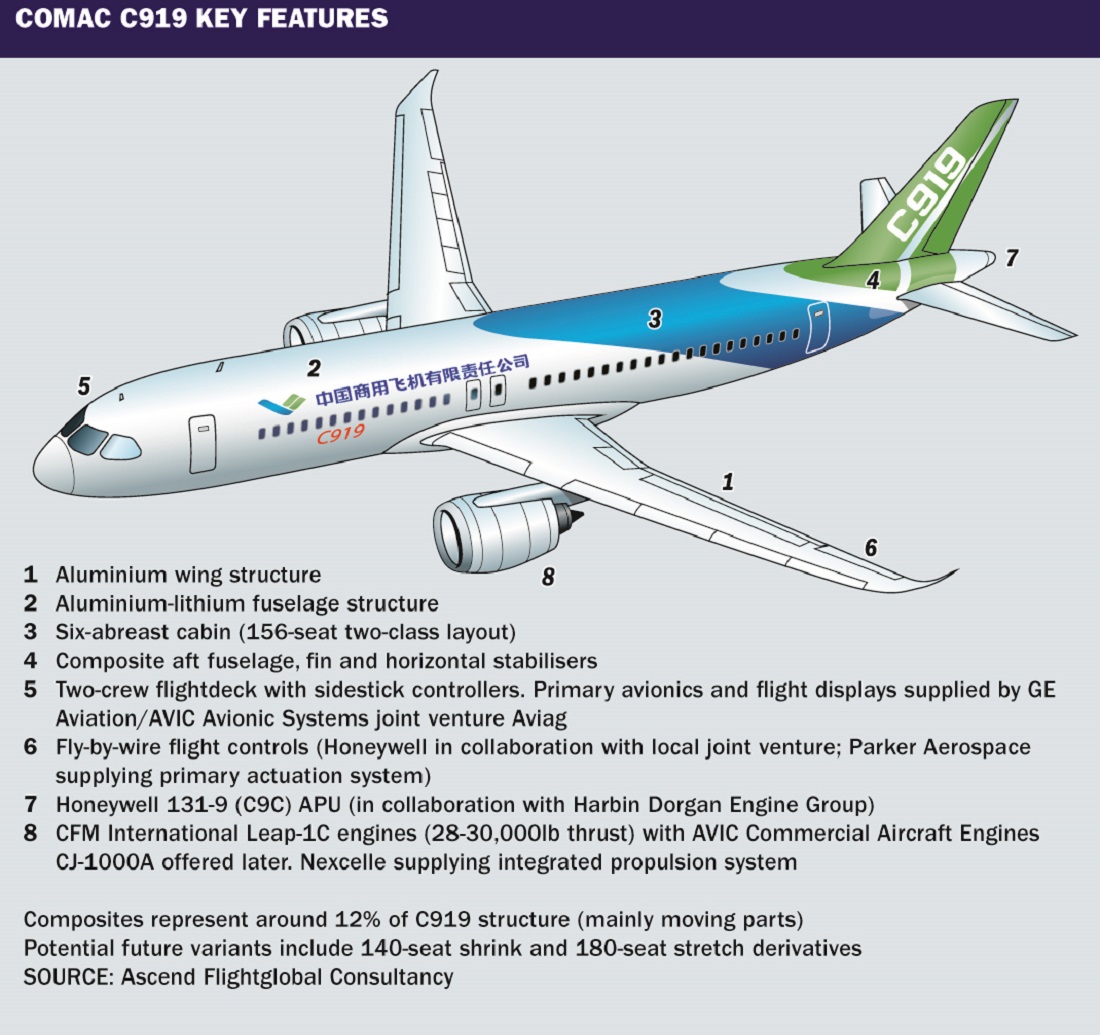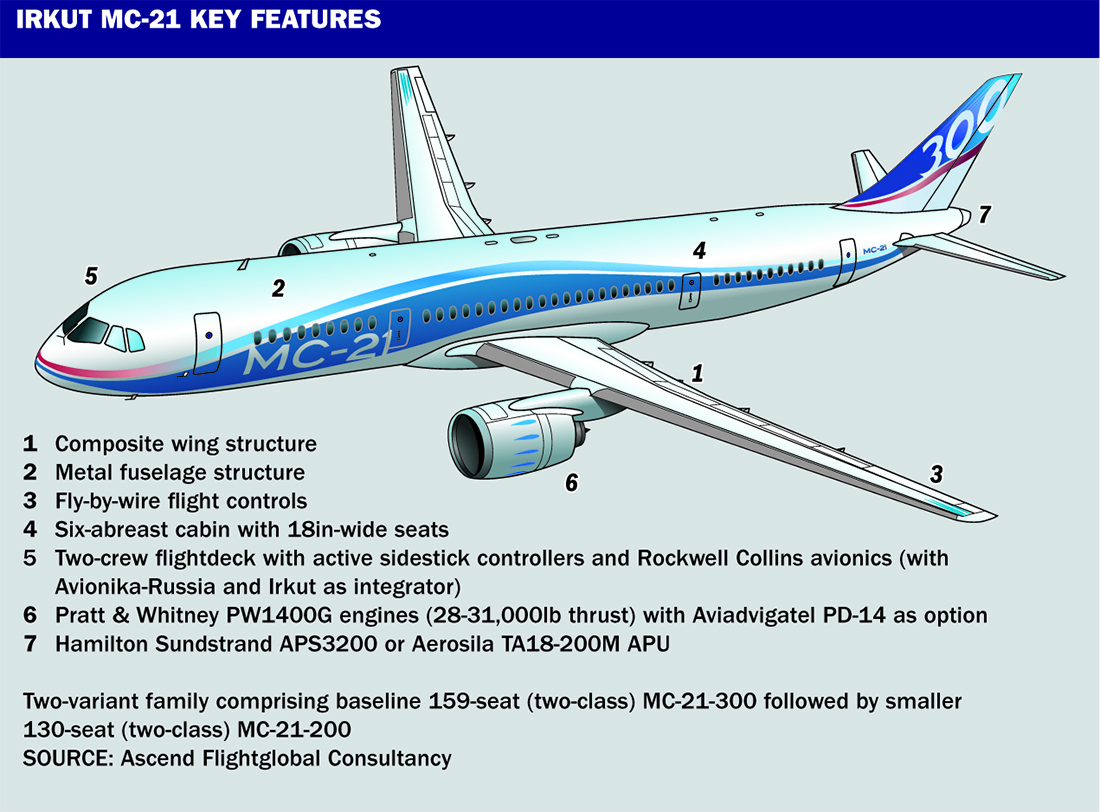This year is a significant one for the mainline jet sector: during 2016, not one but two all-new 150-seat airliners powered by next-generation engines will stake their claim for a slice of a market that for two decades has been the preserve of Airbus and Boeing.
China’s Comac C919 was the first of these shiny new machines to break cover, rolling out in Shanghai in November 2015. As China’s aerospace industry gets ready to fly the CFM International Leap-1C-powered twinjet, Russia’s bid for single-aisle success is poised to make its debut. The Irkut MC-21, the prototype of which should emerge from the company’s plant in Irkutsk in June, is powered by the Pratt & Whitney PW1400G – a derivative of the PW1000G geared turbofan.
While Western manufacturers are supplying the lead powerplants, both new types have engine options developed indigenously, albeit with the participation of international suppliers. The same is true for many of the primary systems, such as the avionics, flight controls and auxiliary power units.
The two twinjets are very similar in general configuration and size to the Airbus A320, incorporating single-aisle six-abreast cabins. And both feature fly-by-wire flight controls and have advanced cockpits equipped with sidesticks – active in the case of the MC-21. Both have metal fuselages, with the C919 adopting composites for the aft fuselage, fin and horizontal stabilisers. China has taken a less risky approach to Russia for the wing structure, plumping for aluminium whereas Irkut has gone with composites for its twinjet.

As things stand, the C919 is offered as a single variant, which seats 156 passengers in a two-class layout or 180 in a high-density configuration. Smaller and larger variants are proposed, but there’s nothing firm yet.
Irkut offers two flavours of MC-21. The baseline -300 typically seats 163 passengers in a two-class layout or up to 211 in a high-density configuration, while the -200 accommodates 135 seats or up to 176 passengers in similar arrangements.

Both types have racked up orders from mainly local airlines and lessors. Flightglobal’s Fleets Analyzer database shows the Russian jet has 181 orders from eight customers (including 50 from flag carrier Aeroflot) and a further 79 options and commitments. Comac has secured orders for 282 C919s (from 13 customers including 10 in China) and a further 232 commitments. Significantly, two major lessors have each committed to take 20 C919s: BOC Aviation – the Singapore-based leasing arm of Bank of China – and GECAS, which is owned by CFM engine partner GE.
Assuming they complete their development and flight-test programmes on schedule, both twinjets are slated to enter service in around two years. And as they now crystallise from drawing board to reality, and flight-testing looms, the aviation world is starting to sit up and take more notice. But do they offer a genuine threat to Airbus and Boeing’s re-engined single-aisles, with which they share powerplant and systems technology, or are they simply national vanity projects that are little more than sophisticated job-creation schemes?
“On paper, both the MC-21 and C919 appear fully competitive in performance and economic terms with the A320neo and 737 Max. But this in itself is unlikely to be enough to convince significant numbers of prospective operators to acquire the aircraft on a global basis,” says Rob Morris, who heads up consultancy at Flightglobal’s Ascend division.
“Because in addition to these, airlines will expect reliability to be as good as today’s A320 and 737. This requires programme targets to be met – and neither manufacturer had managed to demonstrate any track record in this regard to date – then series production needs to be delivered, and most critically, product support on a global basis to ensure training, spares, airworthiness, ‘AOG’ and finance support, etc, are all managed to ensure that 99%-plus dispatch reliability. However, neither type, nor their manufacturer, offers any real degree of innovation over the Airbus and Boeing products and thus it is hard to see them becoming a major player with these projects.”
For his part, Teal Group’s vice-president of analysis Richard Aboulafia is clear that he views the motivation behind these new aircraft as political rather than a perceived market requirement.
“There’s nothing like the prospect of a government-managed, funded, and supported wannabe jetliner that inspires airlines to say ‘thanks, but we’ll take a pass on these’,” he says.
“Back in the Cold War, we had ‘Captive Nations Week’, aimed at showing support for those luckless, grey, depressing countries behind the Iron Curtain. Perhaps now we should have ‘Captive Airlines Week’ aimed at supporting airlines forced by government fiat to buy jets designed and built by those very governments. Thankfully, the number of airlines in that unenviable position is quite small... Even in China, the airline industry is finding ways to assert itself. The agreement to build A320neos in Tianjin and the agreement to finish 737 Max aircraft in China gives Chinese airlines an excuse to continue buying what they want... Western jetliners.”
Aboulafia is also not convinced that the Russian airlines will be forming a long queue for a locally designed and developed airliner, even if it has Western partners. “Well, we will see. Back in the 1990s, Russian airlines were told to keep buying Ilyushin Il-96s and Tupolev Tu-204s. They simply responded with a straightforward question: ‘Does the government want a modest jetliner business or a healthy airline industry?’
WESTERN ALLURE
“The government relented, and Russian airlines got the Western jets they wanted. That killed the Tu-204 and Il-96.”
While these two new programmes are debuting almost simultaneously, one has a technical advantage over the other – at least on paper – says Ascend senior consultant Richard Evans. “The MC-21 is a much more advanced aircraft than the C919. It has a composite wing and an aspect ratio similar to the Bombardier CSeries, so it is arguably more advanced than even the A320neo.
“However, history suggests Russian types are generally higher in operating empty weight, and the new wing must represent an execution risk. If the MC-21 makes its cost and weight targets – which is not completely impossible – it might be a technical threat to the A320neo and 737 Max.”
But even these technical innovations might not be enough for success in the world market, says Evans, as he believes airlines outside Russia would be very wary of support, reliability and maintenance cost, “so a market threat is unlikely”.
The prospects for the C919 offering a genuine threat to Airbus and Boeing are even more limited as it offers no significant step over the original A320, says Evans.

Morris thinks that the new twinjets could hamper Airbus and Boeing sales at Chinese and Russian airlines: “But even in those markets, operators need a fully competitive and reliable product and thus even that will be a tough challenge to overcome. But it is likely that there will be some market share taken from Airbus and Boeing in those markets, albeit small.”
The latest Flightglobal Fleet Forecast predicts that some 2,000 of the two new types will be delivered in the next 20 years (1,250 C919s and 750 MC-21s), representing 8% of the entire single-aisle market during that timeframe. Serial production of the C919 will be on a new assembly line which is scheduled to be completed at Shanghai Pudong airport in 2016 and be capable of outputting 150 aircraft a year by 2020.
However, Evans warns that one needs to look beyond the delivery numbers: “The record of Russian and Chinese manufacturers is that aircraft are delivered, but they do not necessarily stay in service. Many Tu-204/214s or Xian MA60s are parked, or in service at very low utilisation rates, leading to the conclusion that reliability and spares support is poor, and/or the aircraft are not competitive – such that the airline would rather fly Western-built types.”
Another challenge for these airliners if they are to make a dent in the global market concerns their perception in current and future value terms among appraisers and the financial community.
“Clearly, asset-based financing – as we do – is relying on aircraft value and liquidity,” says DVB Bank managing director of aviation research Bert van Leeuwen.
“Both types have not yet reached a stage where we can be comfortable about these key factors. Chinese lessors/airlines have taken positions in the C919, seemingly based on national interests, so that doesn’t mean too much.
“So I wouldn’t expect any ‘Western’ parties to take asset risk on these new designs in the near to medium term, unless based on very strong financial guarantees.”
Ascend’s full-life base value for a 2017 A320neo or 737 Max is around $51 million. “Neither the C919 nor MC-21 currently shows signs of the [A320/737’s] level of market penetration, thus values are likely to be significantly lower and are hard to estimate,” says Morris.
He sees the biggest challenge for both these projects as being able to deliver on promises. “In that regard, neither manufacturer has a proven track record of either innovation or delivery in the commercial sector. Thus, it’s hard to see them breaking the market significantly with these products.”
Source: Airline Business
















